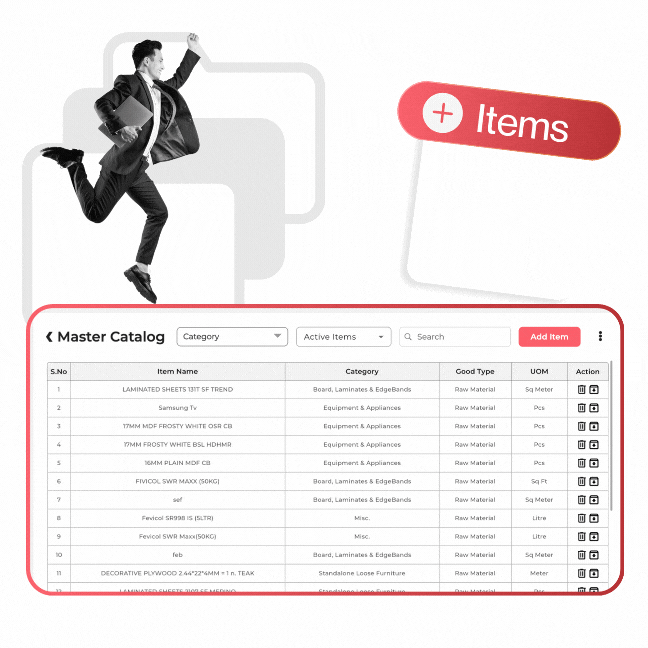Streamline Your Interior Design Operations with Dzylo’s
Inventory Management Software
In today’s fast-paced world, manual efforts can slow you down. That’s why we created Dzylo—to eliminate the hassle of outdated processes. No more juggling spreadsheets or wasting hours on inventory tracking. With quick setup and a user-friendly design, Dzylo helps you stay organized, efficient, and focused on what matters—bringing your creative visions to life.

Inventory management is one of the biggest challenges for construction firms and interior design businesses.
Manual tracking often leads to errors, delays, and miscommunication between teams. Without a real-time inventory management system, it’s nearly impossible to avoid material shortages, overordering, or ghost stock — especially across multiple project sites.
Supply chain disruptions, slow warehouse movement, and disconnected tools only add to the chaos. Teams lose time searching for materials that should be there but aren’t. Without accurate data, decision-making suffers and client trust takes a hit.
That’s why construction-ready, AI-powered inventory tracking software is no longer optional — it’s essential for faster execution, better visibility, and zero stock-related surprises.

Everything you need to manage your interior design inventory operations
At Dzylo, we understand the challenges interior designers face when managing inventory. From sourcing products to tracking their condition, managing numerous items can be time-consuming and error-prone. With our inventory management software, we streamline this process to give you more time for creativity and client satisfaction.

Multiple-Warehouse Inventory Management Software
Dzylo offers seamless management of inventory across multiple warehouses. This means that you can organize your items by warehouse location, project, or style, while ensuring that all inventory movements are tracked across locations.


Easily Track and Control
With Dzylo’s advanced inventory management system, interior designers can easily track and manage inventory that is returned, used, transferred, lost, or damaged. Stay organized and ensure efficient material handling across projects, reducing wastage and optimizing procurement. Dzylo provides real-time updates, making it simpler to maintain accurate records and improve overall project efficiency.
Master Catalogue for Inventory Management
Dzylo’s master catalogue offers a streamlined solution for interior designers to efficiently manage and organize inventory. Track products, monitor stock levels, and ensure consistency across all projects. With centralized product information, designers can make quicker, informed decisions, reducing delays and boosting project efficiency. Keep your inventory organized and up-to-date with Dzylo’s comprehensive management system.



Track Purchasing History
Dzylo maintains a detailed purchasing history, enabling your team to track each item’s history and usage. This helps with better procurement planning and ensures you have the materials needed for upcoming projects.
Let us show you how it works
A member of our team will give you a detailed demo based on your specific needs.
Frequently Asked Questions
What are inventory management software?
Inventory management software are tools that help businesses track stock levels, manage orders, and control inventory across locations. Examples include Zoho Inventory, TradeGecko, and Dzylo’s inventory module.
Can you do inventory management in Excel?
Yes, you can use Excel for basic inventory management by creating spreadsheets with formulas for stock levels, sales, and reordering. However, it’s not ideal because excel sheet have limitations. With inventory management software, you can track, update, share, get reports, history, etc, it can help you save your efforts and time.
Inventory management software for small businesses?
What is ghost stock and how to avoid it?
Ghost stock refers to inventory that appears in your system as available but doesn’t actually exist in your warehouse or at the project site. It often happens due to manual errors, unrecorded usage, or delayed updates – leading to false confidence in stock levels.
